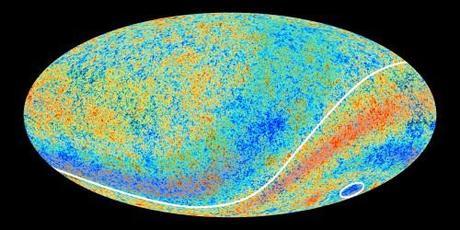“Praise the Lord, who is so good…
Who alone has done great wonders…
Who skillfully made the heavens…
Who spread the earth upon the waters…
Who made the great lights…
The sun to rule the day…
The moon and stars to rule the night…
Praise the God of heaven,
God’s love endures forever.” -Psalm 136

A new map of the Universe’s first light, right after the Big Bang, is forcing cosmologists to revise their notion of how old our Universe is.
Clara Moskowitz reports for Space.com, March 21, 2013, that Europe’s Planck spacecraft has revealed the most detailed map yet of the earliest light in the universe.
That light was released just 380,000 years after the Big Bang, and contains a record of how our universe came to be. The new map tracks small temperature variations in the glow pervading space called the cosmic microwave background (CMB), which reveals some tantalizing anomalies that could point toward new physics:
- The Universe is older than once thought, now estimated to be 13.8 billion years old.
- The Universe is expanding slower than once thought, now calculated to be 41.73 miles (67.15 kilometers) per second per megaparsec. The expansion rate is also known as the Hubble constant, and the new estimate is significantly lower than the values derived through other astronomical observations. (A parsec is a unit of length used in astronomy, equal to about 19.2 trillion miles {or 30.9 trillion km; 3.26 light-years}. A megaparsec is a distance of one million parsecs {approximately 3,260,000 light-years}. Astronomers typically measure the distances between galaxies and galaxy clusters in megaparsecs.) The expansion rate of the universe, in turn, is deeply connected to the idea of dark energy, which is the name scientists have given to whatever is causing the universe’s expansion to accelerate. The new finding could point toward a new direction of thinking about dark energy, including the possibility that it has changed over time.
- Whereas the standard theory of inflation says that after the Big Bang, the Universe rapidly doubled in size every 10^-35 seconds (a decimal point followed by 34 zeroes and a one), and expanded uniformly in all directions, the new data from Planck suggest that might not have been the case. Johns Hopkins University astrophysicist Marc Kamionkowski explains: “One of the features of inflation is it says there should be no preferred direction — everywhere in the universe should be more or less the same. But when you look at the amplitudes, even by eye you can tell that one side of the universe looks different from the other side.” That is to say, the temperature variations in the CMB appear to be sized and spaced differently when Planck looks in one direction, than when it looks in the other.
But the map’s deviations from what was predicted are not cause for disappointment among scientists, but rather exhilaration. They could even lead toward unraveling the mysteries of dark matter and dark energy, two perplexing constituents of the universe that have yet to be explained by mainstream theories.
The Planck data may point to even more radical conclusions, such as the idea of multiple universes and bubble universes created by areas of the primordial universe that inflated at different rates.
As if the above isn’t mind-blowing enough, according to general relativity, space can expand faster than the speed of light, although we can view only a small portion of the Universe due to the limitation imposed by light speed. Since we cannot observe space beyond the limitations of light (or any electromagnetic radiation), it is uncertain whether the size of the Universe is finite or infinite.
~Eowyn

